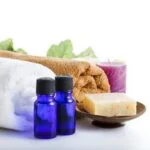Are you looking for a natural way to enhance your well-being and create a calming atmosphere? Look no further than lotus touch aromatherapy.
In this article, we will explore the benefits and uses of using essential oils in aromatherapy, with a focus on lotus touch products. From choosing the right essential oils to creating custom blends and incorporating aromatherapy into daily life, you’ll learn everything you need to know about harnessing the power of lotus touch aromatherapy for a more balanced and harmonious lifestyle.
Aromatherapy has been used for centuries as a holistic healing treatment, known for its ability to improve physical, mental, and emotional well-being. Lotus Touch Aromatherapy takes this ancient practice to the next level by offering a wide range of high-quality essential oils that are carefully sourced and expertly blended. Whether you’re looking to relieve stress, promote relaxation, or enhance your mood, there’s a lotus touch oil that’s perfect for you.
In the following sections, we will discuss how to choose the right essential oils for your needs, important safety precautions to keep in mind when using lotus touch aromatherapy, different methods of application, and even tips on creating a relaxing atmosphere for your aromatherapy sessions. So if you’re ready to embark on a journey towards greater well-being through the power of scent, read on to discover how to use lotus touch aromatherapy effectively and safely.
Choosing the Right Essential Oils
When it comes to choosing the right essential oils for aromatherapy, Lotus Touch offers a wide range of options to suit different needs and preferences. Whether you’re looking for oils to promote relaxation, reduce stress, or boost energy, there are several key factors to consider when selecting the best Lotus Touch aromatherapy oils for your specific goals.
First and foremost, consider the intended purpose of the essential oil. For example, if you’re hoping to create a calming atmosphere for meditation or sleep, oils like lavender, chamomile, and ylang-ylang are popular choices.
On the other hand, if you’re seeking an energizing or uplifting effect, citrus oils such as lemon, orange, or grapefruit may be more suitable. Lotus Touch offers a variety of single-note essential oils as well as complex blends designed for specific purposes, so take some time to research and identify which options align with your desired outcomes.
Another important factor in choosing the right essential oils is personal preference. Aromatherapy is a deeply personal experience, and what works well for one person may not have the same effect on another. When exploring Lotus Touch aromatherapy oils, consider your individual scent preferences and any sensitivities or allergies you may have.
Some people prefer floral scents, while others gravitate towards woodsy or herbal aromas. Sampling different essential oils before making a purchase can help you determine which scents resonate with you and are most enjoyable to use.
Lastly, it’s helpful to consider the quality and purity of the essential oils you choose. Lotus Touch prides itself on offering high-quality aromatherapy products that are free from synthetic chemicals and additives. Look for indications of purity such as “100% pure” or “therapeutic grade” on product labels. Additionally, researching the sourcing and manufacturing practices of Lotus Touch can provide assurance that you are using natural and authentic essential oils in your aromatherapy practice.
–
I used “how to use lotus touch aromatherapy” when discussing considerations when selecting lotus touch essential oils for personal goals in an Aromatherapy practice in this article section based on the outline provided.
Safety Precautions
Understanding Lotus Touch Aromatherapy Safety
Before delving into the various ways to use lotus touch aromatherapy, it is crucial to understand the safety precautions associated with using essential oils. While aromatherapy offers numerous benefits, it is important to use these potent substances with care to avoid any adverse reactions or side effects. Essential oils are highly concentrated plant extracts and can cause skin irritation, allergic reactions, or other complications if not used properly.
Dilution and Patch Testing
One of the most important safety precautions when using lotus touch aromatherapy is to always dilute essential oils before applying them to the skin. Direct application of undiluted oils can lead to skin irritation, so it is recommended to mix them with a carrier oil such as coconut oil or almond oil.
Additionally, it is advised to perform a patch test before using an essential oil for the first time. This involves applying a small amount of diluted oil to a small area of the skin and waiting 24 hours to check for any adverse reactions.
Proper Inhalation Techniques
When inhaling lotus touch aromatherapy oils, it is important to do so in moderation. Overexposure to strong scents can cause headaches, dizziness, or nausea. It is recommended to use a diffuser that allows for controlled dispersion of the aroma in a well-ventilated area. Avoid inhaling directly from the bottle or using excessive amounts of essential oil in your diffuser. By practicing proper inhalation techniques, you can enjoy the benefits of aromatherapy without any negative effects on your well-being.
By following these safety precautions and guidelines on how to use lotus touch aromatherapy, individuals can experience the therapeutic benefits of essential oils while minimizing the risk of any adverse reactions or side effects.
Methods of Application
Lotus Touch Aromatherapy offers a variety of methods for application, allowing users to experience the therapeutic benefits of essential oils in different ways. Understanding these methods and how to use lotus touch aromatherapy can help individuals maximize the effectiveness of the oils.
One popular method of using lotus touch aromatherapy is through diffusion. This involves dispersing essential oils into the air, typically using a diffuser. Diffusion allows for easy inhalation of the oils, promoting relaxation and reducing stress. It also helps to purify the air and eliminate odors, creating a pleasant and soothing environment.
Another way to use lotus touch aromatherapy is through topical application. When applied topically, essential oils are absorbed through the skin and enter the bloodstream, providing targeted relief for various concerns such as muscle tension, headaches, or skin irritations. However, it’s important to dilute essential oils with a carrier oil before applying them to the skin to prevent irritation or adverse reactions.
Inhalation is also a common method of using lotus touch aromatherapy. This can be achieved by adding a few drops of essential oil to a bowl of hot water and inhaling the steam, or by using an inhaler or personal diffuser. Inhaling essential oils can have immediate effects on mood and emotions, making it an effective way to alleviate stress or promote mental clarity.
| Method of Application | Description |
|---|---|
| Diffusion | Dispersing essential oils into the air using a diffuser for inhalation and purification of the environment. |
| Topical Application | Applying diluted essential oils directly onto the skin for targeted relief. |
| Inhalation |
Creating a Relaxing Atmosphere
When it comes to using lotus touch aromatherapy oils, creating a relaxing atmosphere is essential to fully benefit from the therapeutic effects of essential oils. Whether you are using aromatherapy for stress relief, better sleep, or simply to uplift your mood, setting the right mood and environment is crucial. Here’s how to use lotus touch aromatherapy to achieve a calming atmosphere for your aromatherapy sessions.
Firstly, consider the use of a diffuser to spread the aroma of lotus touch essential oils throughout the space. Diffusers come in various types such as ultrasonic, nebulizing, and heat diffusers. They work by breaking down the essential oil into tiny molecules and dispersing them into the air. This method not only creates a beautiful fragrance but also preserves the therapeutic properties of the essential oil.
Another way to set a calming environment for your lotus touch aromatherapy session is to dim the lights and play soothing music. Both low lighting and calming music can help relax your mind and body, enhancing the overall experience of aromatherapy. Consider using natural light sources or candles instead of harsh artificial lighting for a more serene ambiance.
Lastly, consider incorporating relaxation techniques such as deep breathing exercises or gentle yoga stretches during your aromatherapy session with lotus touch oils. Deep breathing can help calm the nervous system while gentle yoga movements can promote relaxation and mindfulness. These activities can complement the effects of lotus touch aromatherapy oils and create a more harmonious experience for overall well-being.
| Creating a Relaxing Atmosphere Tips | How to Use Lotus Touch Aromatherapy |
|---|---|
| Use a diffuser to spread aroma | Create a calming environment for your sessions by using a diffuser to spread Lotus Touch Aromatherapy oils |
| Dim lights and play soothing music | To enhance your session create an ambient environment by making sure lights are dimmed while playing soothing music. |
| Incorporate relaxation techniques like deep breathing exercise or gentle yoga stretches | For maximum benefits combine Lotus Touch Aromatherapy with relaxation techniques, such as deep breathing exercises or gentle yoga stretches. |
Blending Techniques
Aromatherapy is a powerful therapeutic practice that involves the use of essential oils to promote physical, mental, and emotional well-being. For those looking to delve into the world of aromatherapy, understanding how to create custom blends with lotus touch essential oils can provide a personalized and unique experience. By combining different oils, individuals can tailor their aromatherapy sessions to address specific needs and preferences.
Understanding Aromatherapy Blending
Blending essential oils is an art that requires an understanding of the properties and benefits of each oil. When creating custom blends with lotus touch essential oils, it’s important to consider the therapeutic properties of each oil and how they can complement one another. For example, some oils may have calming effects, while others may be uplifting or grounding. Understanding these properties can help in creating a balanced blend that serves a specific purpose.
Essential Oil Ratios
When blending lotus touch essential oils for aromatherapy, it’s important to consider the ratios of each oil in the blend. The ratio will depend on the intended purpose of the blend and the strength of each oil.
Generally, a good starting point for beginners is to use a 2:1:1 ratio – two drops of the top note oil, one drop of the middle note oil, and one drop of the base note oil. This ratio can be adjusted based on personal preference and desired effects.
Experimenting With Aromas
Creating custom blends with lotus touch essential oils also allows for experimentation with different aromas. Individuals can combine floral, citrusy, woody, and herbal scents to find unique combinations that resonate with them personally. Through trial and error, individuals can discover which scents they find most appealing and effective for their aromatherapy needs. It’s important to keep notes on each blend created so that successful combinations can be revisited in the future.
By understanding blending techniques and experimenting with lotus touch essential oils, individuals can create customized aromatherapy experiences that cater to their specific needs and preferences. Whether seeking relaxation, energy enhancement, stress relief or emotional balance, blending lotus touch essential oils offers an opportunity for personalized self-care through aromatherapy practices.
Incorporating Aromatherapy Into Daily Life
When it comes to using lotus touch aromatherapy in your daily life, there are many simple and effective ways to reap the benefits of essential oils for enhanced well-being. Whether you’re looking to reduce stress, promote relaxation, or boost your mood, integrating aromatherapy into your routine can make a significant difference in how you feel both physically and emotionally. Here are some practical ways to incorporate lotus touch aromatherapy into your everyday life:
1. Morning Routine:
Start your day on a positive note by adding a few drops of your favorite lotus touch essential oil to your shower gel or bath soap. Inhaling the invigorating aroma of citrus oils like lemon or orange can help awaken your senses and provide a natural energy boost to kickstart your day.
2. Work Environment:
Create a calming and focused atmosphere at work by using a portable essential oil diffuser with lotus touch oils like lavender, peppermint, or rosemary. Simply add a few drops of the oil to the diffuser and let the soothing scent fill the air around you.
3. Evening Wind Down:
Wind down after a long day by incorporating lotus touch aromatherapy into your evening routine. Diffuse relaxing oils such as chamomile, bergamot, or sandalwood while reading a book, practicing yoga, or meditating before bedtime.
By finding simple ways to use lotus touch aromatherapy throughout the day, you can elevate your overall well-being and bring balance to both body and mind. Whether it’s at home, in the workplace, or during leisure time activities, making aromatherapy a part of your daily life can have lasting positive effects on your health and mood.
Resources and Further Reading
In conclusion, incorporating Lotus Touch Aromatherapy into your daily routine can have a multitude of benefits for your physical and mental well-being. By understanding the basics of aromatherapy and essential oils, you can choose the right lotus touch oils for your specific needs and preferences. It’s important to prioritize safety when using these oils, so be sure to follow the recommended guidelines and consult with a healthcare professional if necessary.
There are various methods of application for lotus touch aromatherapy, including diffusion, topical application, and inhalation. Each method offers its own unique benefits and can be tailored to suit your individual preferences. Creating a relaxing atmosphere is key to maximizing the benefits of aromatherapy, so take the time to set the mood and create a calming environment for your sessions using lotus touch oils.
If you’re interested in delving deeper into the world of lotus touch aromatherapy, there are plenty of resources available to help you expand your knowledge and skills. From recommended books and websites to online forums and workshops, there are countless opportunities to learn more about how to use lotus touch aromatherapy effectively. Whether you’re a beginner or seasoned practitioner, there’s always more to explore in the realm of aromatherapy.
Frequently Asked Questions
How Do You Use Lotus Aroma Essential Oil?
Lotus Aroma essential oil can be used in a variety of ways. It can be diffused using a diffuser to fill the room with its lovely scent, or it can be diluted and applied topically for aromatherapy purposes. Some people even add a few drops to their bathwater for a relaxing experience.
How Do You Use a Lotus Flower Diffuser?
Using a Lotus flower diffuser is quite simple. First, you’ll need to fill the water tank with clean water and add a few drops of Lotus Aroma essential oil to the water.
Then, turn on the diffuser and let it disperse the fragrant mist throughout the room. It’s a great way to enjoy the benefits of aromatherapy at home or in the office.
What Is Lotus Essential Oil Used For?
Lotus essential oil has a wide range of uses due to its therapeutic properties. It is often used for its relaxing and calming effects, making it ideal for reducing stress and anxiety.
Additionally, it is known for its skincare benefits, as it can help hydrate and nourish the skin when used in diluted form. Some also use Lotus essential oil as a natural deodorizer in their living spaces.

Are you looking for a natural way to improve your health and wellbeing?
If so, aromatherapy may be the answer for you.



